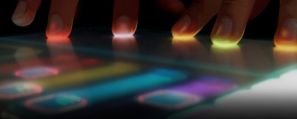 Loading...
Loading...
 Loading...
Loading...

There has been a definite trend towards implementing touch screens in mobile phones. The Apple iPhone has proved to be a huge hit, and its amazing multitouch touch screen was probably one of the major factors. Previously, we published an article about the HTC touch screen technology, TouchFLO 3D, talking about yet another mobile handset manufacturer that has jumped on the bandwagon and is releasing powerful smart phone handsets to their customers.
However, all this time and energy has focused on the mobile handset manufacturers, and not the people who are actually involved in creating and building it. Stantum is just such a company, and they have created a jaw dropping touch screen interface that outshines all others.
Introducing TouchPark
TouchPark is Stantum’s new touch screen technology, and the name does the technology little justice. The sheer range of functionality and features that it packages is simply unbelievable.
First off, the multitouch interface is truly multitouch; in that a user can use any number of digits on the surface – one hand or two, it makes no difference. Even though this is a mind boggling feature in itself, as a matter of fact it isn’t the most interesting feature.
The touch screen is completely pressure sensitive, which means that the technology can sense the force applied by the fingertip. It calculates this based upon many factors, one of which is how much of the surface area of the phalange is in contact with the screen. This pressure sensitivity was displayed on the touch screen with the aid of a status bar.
Methods of input can vary significantly, as a user can opt for anything from using a stylus or their fingers, to something as extraordinary as a paintbrush. This was demonstrated on the screen on a blank canvas and a palette. The screen is sensitive enough to pick up the minute pressure of the brush bristles, although it of course couldn’t mimic the other facets of painting – that would be very unreasonable to even expect.
The accuracy of the touch screen is incredibly high, with the usual touch screen jitters completely eradicated. To demonstrate, contact was applied to the screen, which was then magnified considerably. The results were plainly visible: the touch screen hardware was still not enough to fully showcase and therefore handle the level of sensitivity possible with the technology. A truly incredible function, this accuracy will serve to reduce errors in inputs considerably.
Expected availability
Unfortunately for the users, there is no indication as to when this technology will be available in terms of actual handsets. It has been designed to be incorporated into any operating system, ranging from Symbian to Android. The designers seem to be unsure of how exactly this technology will slot into mainstream phones. However, one thing is fairly certain, whenever it does decide to appear, the response will be quite overwhelming. Hopefully the phones that will have the technology will have other great features as well.
Check out the Engadget website to view a demonstration video of the technology by the designers, here.